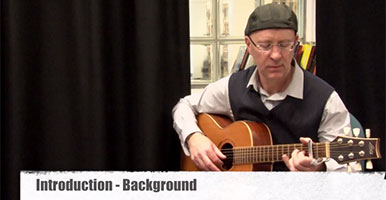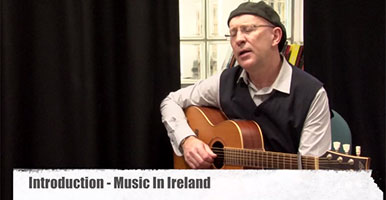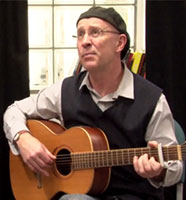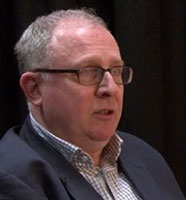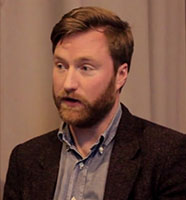James Joyce's "Chamber Music"
A Learning Resource
Background
It’s a well-established fact of literary history that music was at the centre of James Joyce’s life and art. Although celebrated as one of the greatest writers of the twentieth century, Joyce’s artistic vision was essentially musical. He ‘heard’ the world more than he saw it; his ideas about society, and about how the human fits into society, were shaped to a great extent by his own musical imagination, which in turn was largely determined by the general cultural atmosphere in which he was born and raised. Put simply, Ireland is a musical country, Dublin was a musical city, and the Joyces were a musical family.
It’s only fitting, then, that the first book published by the ‘Young Man’ who was to go on to become such a great ‘Artist’ should be one so thoroughly inspired by, and infused with, music. Although the lyrics in Chamber Music were in the main little more than formal exercises – based on the model of the Elizabethan ‘love ayre’ (short, dense meditations in which the lover sings, accompanying himself on lute, to his love) – in retrospect Joyce realised that in these early writings he was working out many of the formal and thematic concerns that were to exercise him throughout the remainder of his career. Although partially predating their meeting, the poems also figured significantly in Joyce’s wooing of Nora Barnacle, the woman with whom he fled Dublin in October 1904 and with whom he spent the rest of his life. In December 1909, shortly after a major crisis in their relationship, Joyce presented Nora with a manuscript of Chamber Music, copied out in India ink on specially cut sheets of parchment, with her initials and his entwined on the cover. He also commissioned a special necklace for her bearing an inscription from one of the Chamber Music lyrics: ‘Love is unhappy when love is away’.
The extent to which Chamber Music constitutes a coherent cycle of love poems – detailing the many facets of an affair from its inception to its death – remains at issue amongst literary historians. (See the comments made by Professor Matthew Campbell in his introduction to the sequence; see also the ‘References’ section of a selection of material of Joyce’s engagement with music in general, and in Chamber Music in particular.) In this version, we have in fact changed the original order (chosen by Joyce’s brother, Stanislaus, after James had apparently lost interest in the matter) to one that we believe more conducive to the properly cyclical structure that the author first conceived.
The ordering of the sequence may remain at issue, but one thing seems clear: Joyce was adamant in insisting upon the musical identity of the collection – that these lyrics be regarded not (or not just) as ‘poems-to-be-read’ but as ‘songs-to-be-sung’.
As soon as the collection appeared people began to set the lyrics. Joyce’s favourite treatments were by a relatively obscure Anglo-Irish composer named Geoffrey Molyneux Palmer. Palmer set thirty two of the thirty-six poems, but remained strangely hesitant when it came to having his adaptations published or performed. Perhaps he was put off by Joyce’s reputation as a ‘risqué’ author. Others have not been so chary. Amongst the very many who have set one or more of the poems from Chamber Music are: Samuel Barber, Syd Barrett, Luciano Berio, Brian Boydell, Frank Bridge, Anthony Burgess, Ross Lee Finney, Ed Harcourt, Stanley Holloway, Nina Karlsson, Ivan Pawle, Mercury Rev, and Gerard Victory.
It’s fair to say that responses from the art tradition have predominated; given Joyce’s own background and tastes, such may indeed constitute the ‘natural’ musical language with which to approach these lyrics. Despite the depth and breadth of his musical imagination, the piano-accompanied tenor, and the ‘through-composed’ song, remained in many ways Joyce’s musical ideal. Nevertheless, as one may observe from the previous list, musical versions of the lyrics from Chamber Music have been essayed in many different styles and traditions. There is, besides, that enduring image of the loved-up troubadour singing to his beloved accompanied only by his lute. If the musical articulation of that image – as represented by the likes of John Dowland and William Byrd – leads in one direction towards the art song and the ideal of through-composition, it also retains the possibility of other musical languages.
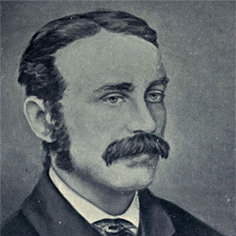
"All art constantly aspires towards the condition of music"
A new version
One of the languages that inspired this rewriting of the Chamber Music poems. I’m referring specifically to the folky, guitar-playing, ballad-singing individual whose work and image continue to feature so strongly within modern popular music. Clearly, that older model (singer and accompanist) hasn’t been lost entirely: but the invocation of a more modern tradition (which itself draws in some respects on the idea of the ‘minstrel’) brings a range of different things to the table. And it’s the strength and the beauty of that tradition – one singer, one guitar, one song – which we’ve attempted to draw on here.
Many of the interpretations included in this version make reference (with greater or lesser awareness, it should be said) to various styles and images ‘borrowed’ from modern ‘folk’ music. The fountainhead of that tradition – at least in its Anglophone strand – is Bob Dylan. Especially in early compositions such as ‘Girl from the North Country’ (written under the influence of the great English folk singer Martin Carthy), ‘One Too Many Mornings’ and ‘Tomorrow Is a Long Time’, Dylan revealed himself as a master of the bitterly reflective love ballad. We’re not aware of directly ‘quoting’ Dylan in any of the compositions on our album; like anyone over the last five decades who has composed and performed (on guitar) a love / loss ballad, however, we owe him a debt of some kind.
Other ‘voices’ from the modern folk tradition are invoked at various points throughout the collection. (Many of these voices are explicitly identified in the videos which introduce each song.) A number of tracks feature the fluid guitar style (based on a double-thumbed bass technique) which is particularly associated with the playing of people like Paul Simon and Gordon Lightfoot in the 1960s: #9 (‘Winds of May’); #14 (‘In the Dark Pinewood’), and #28 (‘Gentle Lady, Do Not Sing’), for example. Number 20 (‘This Heart That Flutters Near My Heart’) bears the bluegrass influence of American folk singer Richard Shindell; while #21 (‘Silently She’s Combing’) alludes to the distinctive rhythmic style of Nic Jones. Number 24 (‘Of That So Sweet Imprisonment’) initially invoked the sound of Mudslide Slim-era James Taylor; with a new arrangement necessitated by a key change, the finished arrangement utilised the open G tuning (DGDGBD) associated with the music of Joni Mitchell.
And so on. We are conscious of the indirect influence on individual songs of Leonard Cohen, Stevie Nicks and Richard Thompson; listeners will no doubt discern echoes that we have missed – but that is the nature of music, is it not: to use and extend existing styles and idioms to articulate something new, something original?
Speaking of alternative tunings, it should be noted that thirty-two of the thirty-six songs in this cycle were initially composed using a non-standard guitar tuning named (after its retuned strings) DADGAD. Two were composed in standard tuning [EADGBE], and two in open G. Many of the initial arrangements were changed when the songs were transposed to suit Esther’s voice.
DADGAD is very popular amongst folk (and some blues) musicians, because it enables a range of effects not readily available in standard tuning. In particular, it facilitates easy slippage between major and minor modes, while it’s also well set for the Mixolydian, Dorian and Aeolian modes commonly used in Irish traditional music. Played by itself, DADGAD provides a sound (a sustained 4th chord) which hovers between major and minor modes. It was deliberately chosen at the beginning of this project as a kind of harmonic signature precisely in order to mitigate so far as possible the domination of western tonality, and the kinds of emotional effects associated with that discourse.
Another interesting feature is the use of some relatively unusual time signatures: 5/4 (#6 ‘Lean Out of the Window, Goldenhair’); 7/4 (#7 ‘Who Goes Amid the Green Wood’; 9/8 (#8 ‘My Love Is in a Light Attire’); 12/8 (#26 ‘What Counsel Has the Hooded Moon’); and a mixture of 4/4 and 3 /4 in #23 (‘O, It Was Out by Donnycarney’).
The 12/8 time signature mentioned above is sometimes referred to as ‘Jig Time’, and this raises the issue of Joyce’s Irish inheritance. One obvious aspect of that inheritance was the great Irish poet and songwriter Thomas Moore, and his series of ‘Melodies’ – so popular amongst the well-off in Britain as well as Ireland – published over an extended period of time in the first half of the nineteenth century. There appears to be only one overt reference to Ireland in Chamber Music – #23 (‘O, It Was Out by Donnycarney’), and Joyce was famously sceptical of any Irish influences on his own work; nevertheless, this was another aspect of the collection’s identity to which we wished at least to allude. The modal opportunities afforded by DADGAD have already been mentioned in relation to #26 which suggests the beautiful guitar work of Irish player Sonny Condell. The ghost that haunts the famous song ‘She Moves through the Fair’ hovers also around #19 (‘From Dewy Dreams My Soul Arise’). Without tying ourselves down to specific characteristics or attributes, neither would we would deny Irish resonances in #2 (‘Strings in the Earth and Air’), #8 (‘My Love Is in a Light Attire’), or #15 (‘Go Seek Her Out All Courteously’).
Other points of note include the monotonic melody of #35 (‘All Day I Hear the Sound of Waters’) which was of course suggested by the lyric itself; and the fact that the scansion of the second verse of #5 (‘When the Shy Star Goes Forth in Heaven’) bears a close resemblance to the theme from the BBC comedy series Blackadder!
Joyce’s minor work deserves to be better known, and I hope that this new setting of his lyric sequence and the materials available on this site can make a contribution to the further understanding and enjoyment of his work.
Gerry Smyth
Liverpool


